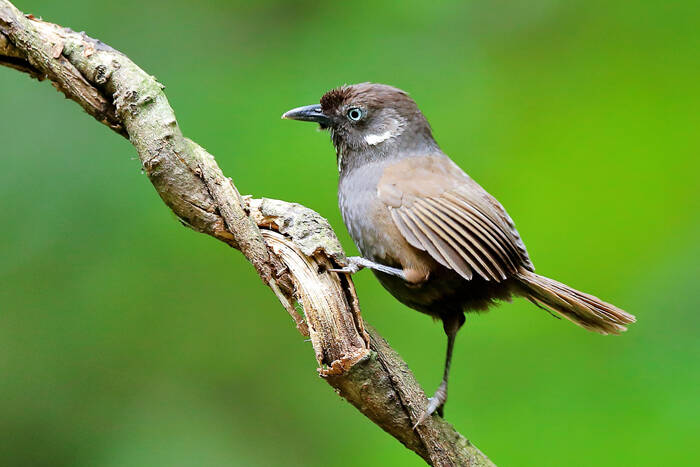Stachyris nonggangensis
IUCN
LCBasic Information
Scientific classification
- name:Stachyris nonggangensis
- Scientific Name:Stachyris nonggangensis,Nonggang Babbler,
- Outline:Songbird
- Family:Passeriformes Thrushidae S.Babbler
Vital signs
- length:About 18 cm
- Weight:About 15-25g
- lifetime:No verification information
Feature
Very rare, with a total population of less than 2,000 individuals
Distribution and Habitat
Nonggang Spike-thrush was discovered in the Nonggang Nature Reserve, China in 2008 (described by Zhou Fang and Jiang Aiwu 2008, Jiang Aiwu 2009). The species is distributed in the southwestern part of Guangxi, adjacent to the Sino-Vietnamese border and Vietnam. Its presence in Vietnam has yet to be confirmed, and suitable habitats may extend to Yunnan Province, China. Nonggang Spike-thrush is a typical karst bird, only distributed in karst mountainous areas and highly dependent on karst forests. It lives in seasonal rainforests in the Excentrodendron hsienmu forest. The main distribution area is found in the Nonggang National Nature Reserve in Longzhou County, Guangxi, China. In addition, there are also small distributions in the Bangliang Nature Reserve in Jingxi County and the Chunxiu Nature Reserve in Longzhou County.
Appearance
The body length of the Longgang Spike is about 18cm, the wingspan is 68mm, the tail length is 61mm, the beak length is 19mm, and the tarsometatarsus is 29mm. Most of the body is dark brown, except for crescent-shaped white spots on the cheeks and behind the ears. The throat and chest are mainly white with black spots, and the eyes have blue irises. The flight feathers and tail are brown. Judging from the fact that there are only two specimens at present, there is no sexual dimorphism, little individual difference, changes in breeding feathers, etc.
Details
Nonggang Babbler, with no subspecies.

In 2004, Professor Zhou Fang of the College of Animal Science and Technology of Guangxi University, funded by the National Natural Science Foundation, went to different regions of Guangxi for field investigations many times. In February, July, and October 2005 to January 2006, an unrecorded species of thrush was observed several times in the Nonggang National Nature Reserve. On January 21, 2006, they captured two birds (one male and one female) for the first time, and identified them as a new species after comparing them with many birds of the same genus.
Zhou Fanghe and Jiang Aiwu published their academic results in the authoritative journal of birds, "The Auk". "The Auk" magazine is edited and published by the American Ornithological Society and is one of the most authoritative academic journals on birds in the world. This is the first time that the name of a mainland Chinese scholar has appeared in the journal. The new species of bird was named Stachyris nonggangensis, with the Chinese name Nonggang Babbler and the English name Nonggang Babbler. It was discovered in the Nonggang National Nature Reserve in Guangxi. Zhou Fang introduced that among the more than 1,300 bird species distributed in China, only the Golden-browed Babbler, which was found in Guangxi, was named and published by Chinese scholar Ren Guorong in 1932. The rest were named, described and published by foreign scholars. The discovery of the Nonggang Babbler in the karst seasonal rainforest in Nonggang, Guangxi, is the first record of a new bird species in China and even in Southeast Asia after more than 70 years. It is relatively easy to discover new species of plants or insects, but it is very difficult to discover new species of birds.
The Nonggang Babbler only forages in the lower layer of the forest. The foraging place changes with the change of seasons. In the rainy season, it forages on the hillsides with higher altitudes and less tree cover. In the dry season, it forages on the hillsides with lower altitudes, more shrubs, greater tree cover, and thicker fallen leaves.
The Nonggang Babbler is shy. It spends little time in trees or flying, and only flies short distances when frightened. The flying height is generally no more than 5 meters. It usually moves by jumping on rocks, lianas, bushes, and branches. In most cases, Nonggang Babbler forages on the ground, looking for insects and arthropods by turning over the gravel under the fallen leaves. In the non-breeding season, 5 to 10 birds are often seen foraging together, and in the breeding season, they appear in pairs. After entering the breeding pair, Nonggang Babbler mainly chooses habitats with a high degree of concealment as their habitat. Therefore, it is difficult to observe Nonggang Babbler during the breeding season.
Nonggang Babbler generally enters the breeding season in mid-to-late March, and builds its nest in a stone cave on a tall rock or cliff. The breeding success rate of Nonggang Babbler is low.
Nonggang Spike-thrush is currently only distributed in Nonggang Nature Reserve. It seems to have no interest in other landforms. It has never been found in the vast woods nearby, and is only active in the limestone area of the nature reserve. Although it is currently protected by its activities in the nature reserve, the rainforest outside the reserve is facing the crisis of being cut down, and its habitat may be severely damaged. Southwest Guangxi, China is a typical northern tropical and karst rocky mountain area. It is a fragile ecological environment system. Once destroyed, it is difficult to recover. In addition, it has been cut down on a large scale in the past. Now there are only some small shrubs growing in the mountains in many areas. The rocky mountain area is seriously desertified and it is difficult to restore vegetation. Nonggang Spike-thrush is highly dependent on karst forests and has high requirements for habitats. Therefore, strengthening the protection of karst forests is the basis for protecting Nonggang Spike-thrush.
Listed in the IUCN Red List of Threatened Species in 2016 ver 3.1 - Vulnerable (VU).
Listed in China's National List of Key Protected Wildlife (February 5, 2021) Level 2.
Protect wildlife and eliminate game.
Maintaining ecological balance is everyone's responsibility!








